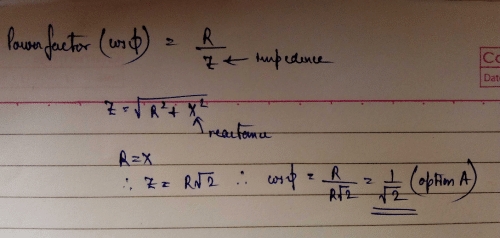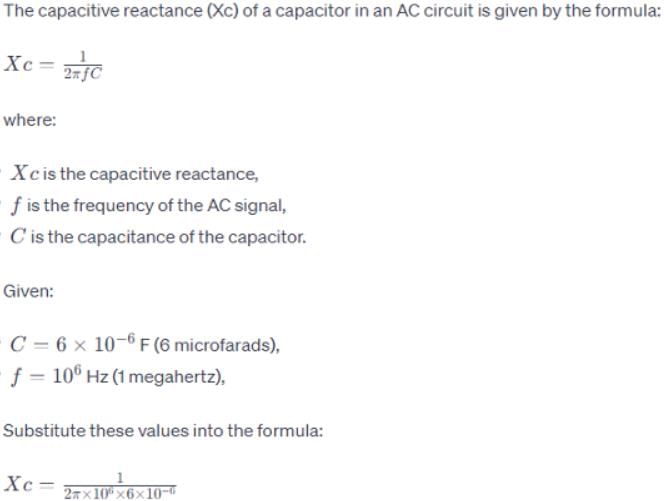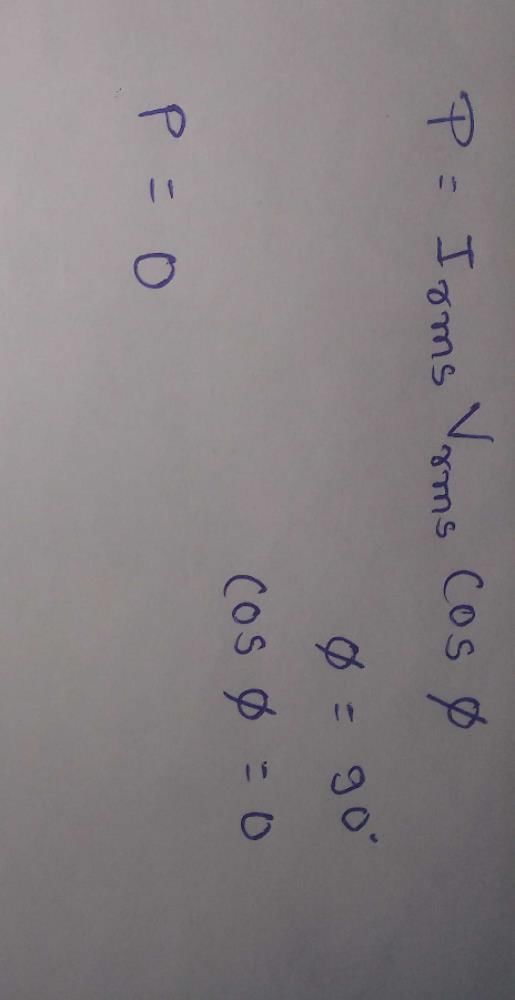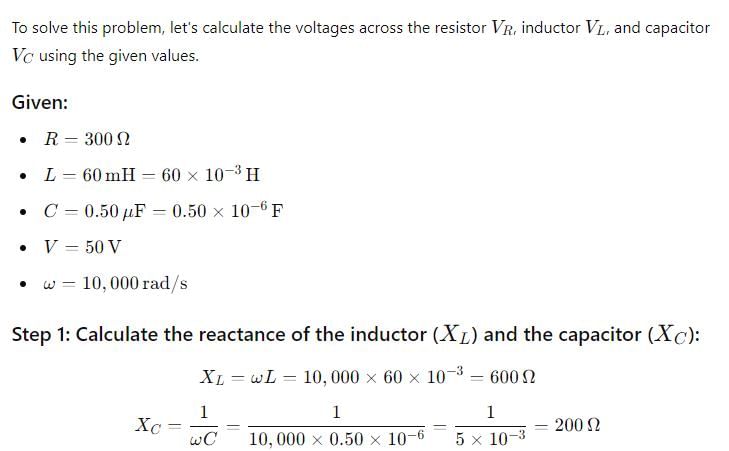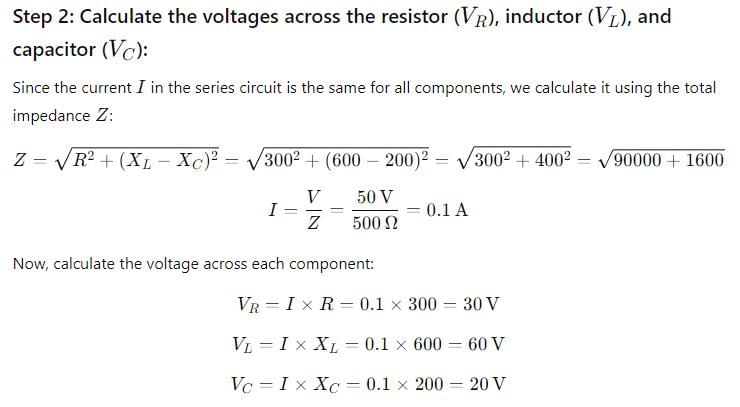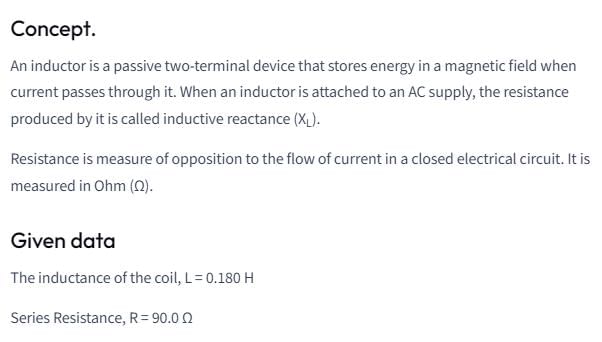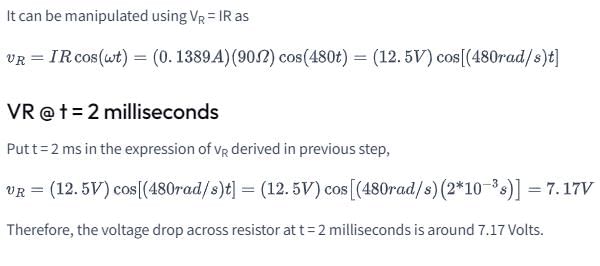All Exams >
NEET >
NCERT Based Tests for NEET >
All Questions
All questions of Alternating Current for NEET Exam
Alternating current is represented by- a)

- b)

- c)

- d)

Correct answer is option 'A'. Can you explain this answer?
Alternating current is represented by
a)
b)
c)
d)

|
Divey Sethi answered |
Alternating current is an electric current which periodically reverses direction, as opposed to direct current which flows only in one direction. And it can be easily represented by the periodic function.
So, I = Io sin wt or I = lo cos wt.
So, I = Io sin wt or I = lo cos wt.
The average power dissipation in pure resistive circuit is:- a)

- b)

- c)

- d)

Correct answer is option 'D'. Can you explain this answer?
The average power dissipation in pure resistive circuit is:
a)
b)
c)
d)

|
Divey Sethi answered |
Power=IV
Where I=Vrms value of current=IV
And V=Vrms value of voltage=EV
Therefore, P=EVIV
Where I=Vrms value of current=IV
And V=Vrms value of voltage=EV
Therefore, P=EVIV
Find the instantaneous voltage for an a.c. supply of 200V and 75 hertz- a)E = 282.8 sin 50πt
- b)E = 282.8 sin 150πt
- c)E = 282.8 sin 75πt
- d)E = 282.8 sin 100πt
Correct answer is option 'B'. Can you explain this answer?
Find the instantaneous voltage for an a.c. supply of 200V and 75 hertz
a)
E = 282.8 sin 50πt
b)
E = 282.8 sin 150πt
c)
E = 282.8 sin 75πt
d)
E = 282.8 sin 100πt
|
|
Krishna Iyer answered |
Answer :- b
Solution :- f = 75hz
w=2πf
= 2 * π * 75
= 150π
E(max) = (2)^½ E(rms)
E(max) = 1.414 * 200
= 282.8V
E(ins) = E(max)sinwt
E(ins) = 282.8 sin 150πt
Which is more dangerous?- a)220 V a.c
- b)220 V d.c
- c)Both 220 V a.c. and 220 V d.c
- d)Both 220 V a.c. and 220 V d.c. are not dangerous
Correct answer is option 'A'. Can you explain this answer?
Which is more dangerous?
a)
220 V a.c
b)
220 V d.c
c)
Both 220 V a.c. and 220 V d.c
d)
Both 220 V a.c. and 220 V d.c. are not dangerous

|
Gargey Dudhe answered |
Because in DC the potential difference is max 220 V but in AC the potential difference is greater than 220V .So AC is more dangerous than DC.pls upvote and follow me.
In an inductance the current- a)is in phase
- b)leads the voltage
- c)lags the voltage
- d)builds very fast
Correct answer is option 'C'. Can you explain this answer?
In an inductance the current
a)
is in phase
b)
leads the voltage
c)
lags the voltage
d)
builds very fast
|
|
Krishna Iyer answered |
In an inductor, current lags behind the input voltage by a phase difference of π/2.
Current and voltage are in the same phase in the resistor whereas current leads the voltage by π/2 in a capacitor.
So, the circuit must contain an inductor only.
Current and voltage are in the same phase in the resistor whereas current leads the voltage by π/2 in a capacitor.
So, the circuit must contain an inductor only.
The only component that dissipates energy in ac circuit is:- a)Capacitor
- b)Inductor
- c)Resistors
- d)None of these
Correct answer is option 'C'. Can you explain this answer?
The only component that dissipates energy in ac circuit is:
a)
Capacitor
b)
Inductor
c)
Resistors
d)
None of these
|
|
Hansa Sharma answered |
The only component that dissipates energy in ac circuit is the resistor because Pure Inductive and pure capacitive circuits have no power loss.
What is the relationship between Em and E0- a)Em=-0.537 E0
- b)Em=-0.737 E0
- c)Em=-0.637 E0
- d)Em=-0.707 E0
Correct answer is option 'C'. Can you explain this answer?
What is the relationship between Em and E0
a)
Em=-0.537 E0
b)
Em=-0.737 E0
c)
Em=-0.637 E0
d)
Em=-0.707 E0
|
|
Om Desai answered |
peak value Em=2E0/π
so 2/π value is 0.637
therefore,
Em=-0.637 E0
so 2/π value is 0.637
therefore,
Em=-0.637 E0
Admittance is reciprocal of- a)Susceptance
- b)Reactance
- c)Impedance
- d)Capacitance
Correct answer is option 'C'. Can you explain this answer?
Admittance is reciprocal of
a)
Susceptance
b)
Reactance
c)
Impedance
d)
Capacitance

|
Aashika Packiaselvam. answered |
Look.. Impendenc means a kind of opposition to a steady electric current ie. resistance. While admittance is a measure to how easily a circuit or device will allow a current to flow. Here by looking at the definition itself, we can clearly say that they are inverse of each other.
Power in an ac circuit is equal to- a)Instantaneous voltage X Instantaneous current
- b)Instantaneous voltage X current at an instant
- c)Voltage at an instant X Instantaneous current
- d)Both b and c
Correct answer is option 'A'. Can you explain this answer?
Power in an ac circuit is equal to
a)
Instantaneous voltage X Instantaneous current
b)
Instantaneous voltage X current at an instant
c)
Voltage at an instant X Instantaneous current
d)
Both b and c

|
Imk Pathsala answered |
Explanation:
Power in an AC circuit is equal to Instantaneous voltage X Instantaneous current:
- In an AC circuit, both voltage and current vary with time, and power is the rate at which work is done or energy is transferred.
- Power in an AC circuit is given by the product of the instantaneous voltage and the instantaneous current at any given moment.
- This means that at any instant, the power being dissipated or consumed in the circuit can be calculated by multiplying the instantaneous voltage and current values at that particular moment.
- Mathematically, the formula for power in an AC circuit is P = V(t) * I(t), where P is power, V(t) is the instantaneous voltage, and I(t) is the instantaneous current at a given time t.
- Therefore, the correct answer is A: Instantaneous voltage X Instantaneous current.
Power in an AC circuit is equal to Instantaneous voltage X Instantaneous current:
- In an AC circuit, both voltage and current vary with time, and power is the rate at which work is done or energy is transferred.
- Power in an AC circuit is given by the product of the instantaneous voltage and the instantaneous current at any given moment.
- This means that at any instant, the power being dissipated or consumed in the circuit can be calculated by multiplying the instantaneous voltage and current values at that particular moment.
- Mathematically, the formula for power in an AC circuit is P = V(t) * I(t), where P is power, V(t) is the instantaneous voltage, and I(t) is the instantaneous current at a given time t.
- Therefore, the correct answer is A: Instantaneous voltage X Instantaneous current.
Given the instantaneous value of current from a.c. source is I = 8 sin 623t. Find the r.m.s value of current- a)5.656 A
- b)8 A
- c)2.848 A
- d)1.414 A
Correct answer is option 'A'. Can you explain this answer?
Given the instantaneous value of current from a.c. source is I = 8 sin 623t. Find the r.m.s value of current
a)
5.656 A
b)
8 A
c)
2.848 A
d)
1.414 A
|
|
Om Desai answered |
Compare the given eqn. with the standard from I=I0sinωt
I0=8, Irms=I0/√2=8/√2=5.656A
I0=8, Irms=I0/√2=8/√2=5.656A
In a series LCR what will be phase difference between voltage drop across inductor and capacitor- a)0
- b)90
- c)180
- d)45
Correct answer is option 'C'. Can you explain this answer?
In a series LCR what will be phase difference between voltage drop across inductor and capacitor
a)
0
b)
90
c)
180
d)
45

|
Rajendri Rani answered |
Because In C-R circuit current lead by π/2 and in L-R circuit voltage lead by π/2 so after drawing the phasor diagram and current will be same so the phase difference is 2π
What is the unit of Capacitive Reactance Xc?- a)Ohm
- b)Ohm2
- c)Ohm-1
- d)mhO
Correct answer is option 'A'. Can you explain this answer?
What is the unit of Capacitive Reactance Xc?
a)
Ohm
b)
Ohm2
c)
Ohm-1
d)
mhO
|
|
Krishna Iyer answered |
The opposition offered by a capacitor for the flow of A.C is called capacitive reactance.
Xc = 1/wC
it's SI unit is ohm
Xc = 1/wC
it's SI unit is ohm
If a capacitor of capacitance 9.2F has a voltage of 22.5V across it. Calculate the energy of the capacitor.- a)5062.5 J
- b) 2328.75 J
- c)50.625 J
- d)50625 J
Correct answer is option 'B'. Can you explain this answer?
If a capacitor of capacitance 9.2F has a voltage of 22.5V across it. Calculate the energy of the capacitor.
a)
5062.5 J
b)
2328.75 J
c)
50.625 J
d)
50625 J
|
|
Geetika Shah answered |
We know that,
ω=(1/2)CV2
After putting the values,
=(1/2)x9.2x22.5x22.5
=2328.75J
Hence option B is the answer.
ω=(1/2)CV2
After putting the values,
=(1/2)x9.2x22.5x22.5
=2328.75J
Hence option B is the answer.
Power factor of an L-R series circuit is 0.6 and that of a C_R series circuit is 0.5. If the element (L, C, and R) of the two circuits are joined in series the power factor of this circuit is found to be 1. The ratio of the resistance in the L-R circuit to the resistance in the C-R circuit is- a)6/5
- b)5/6
- c)

- d)

Correct answer is option 'D'. Can you explain this answer?
Power factor of an L-R series circuit is 0.6 and that of a C_R series circuit is 0.5. If the element (L, C, and R) of the two circuits are joined in series the power factor of this circuit is found to be 1. The ratio of the resistance in the L-R circuit to the resistance in the C-R circuit is
a)
6/5
b)
5/6
c)
d)
|
|
Jyoti Sengupta answered |
cosϕ1=0.6=5/3
tanϕ1=4/3= XC/R2…(1)
cosϕ1=0.5=1/2
tanϕ2=√3= R2/XC…(2)
From (1) and (2)3√3/4=R1/R2
tanϕ1=4/3= XC/R2…(1)
cosϕ1=0.5=1/2
tanϕ2=√3= R2/XC…(2)
From (1) and (2)3√3/4=R1/R2
The current amplitude in a pure inductor in a radio receiver is to be 250 μA when the voltage amplitude is 3.60 V at a frequency of 1.60 MHz (at the upper end of the AM broadcast band). If the voltage amplitude is kept constant, what will be the current amplitude through this inductor at 16.0 MHz?- a)20.0 μA
- b)33.0 μA
- c).35.0 μA
- d)25.0 μA
Correct answer is option 'D'. Can you explain this answer?
The current amplitude in a pure inductor in a radio receiver is to be 250 μA when the voltage amplitude is 3.60 V at a frequency of 1.60 MHz (at the upper end of the AM broadcast band). If the voltage amplitude is kept constant, what will be the current amplitude through this inductor at 16.0 MHz?
a)
20.0 μA
b)
33.0 μA
c)
.35.0 μA
d)
25.0 μA
|
|
Preeti Khanna answered |
I0=250μA, v0=3.6v . v=1.6x106 Hz
Here,
(Reactance of inductance) XL=ωL
XL=2πv X L
v0/I0=2πv x L
3.6/2.5x10-4=2πx1.6x10-6 x L
0.14x104-6=L
L=0.14x10-2H
Now for v=16.0x106Hz
XL=2πv X L
=2πx16x106x14x10-4
XL=1407x102Ω
Now,
v0=I0 x XL
3.6/1407x102=I0 [∵v0=kept constant.]
I0=0.00256x10-2
I0=25.6μA
Here,
(Reactance of inductance) XL=ωL
XL=2πv X L
v0/I0=2πv x L
3.6/2.5x10-4=2πx1.6x10-6 x L
0.14x104-6=L
L=0.14x10-2H
Now for v=16.0x106Hz
XL=2πv X L
=2πx16x106x14x10-4
XL=1407x102Ω
Now,
v0=I0 x XL
3.6/1407x102=I0 [∵v0=kept constant.]
I0=0.00256x10-2
I0=25.6μA
Find the series resonance frequency when L = 0.09 H, C = 25 F- a)10.6 s-1
- b)0.106 s-1
- c)1.66 s-1
- d)1.06 s-1
Correct answer is option 'B'. Can you explain this answer?
Find the series resonance frequency when L = 0.09 H, C = 25 F
a)
10.6 s-1
b)
0.106 s-1
c)
1.66 s-1
d)
1.06 s-1
|
|
Lavanya Menon answered |
ω=1/√LC
ω=1√0.09x25
ω=0.666
ω=2πf
f=0.666/(2 x 3.14)
f=0.106 s-1
ω=1√0.09x25
ω=0.666
ω=2πf
f=0.666/(2 x 3.14)
f=0.106 s-1
Let f = 50 Hz, and C = 100 mF in an AC circuit containing a capacitor only. If the peak value of the current in the circuit is 1.57 A at t = 0. The expression for the instantaneous voltage across the capacitor will be- a) E = 50 sin (100 pt – p/2)
- b)E = 100 sin (50 pt)
- c)E = 50 sin 100 pt
- d)E = 50 sin (100 pt + p/2)
Correct answer is option 'C'. Can you explain this answer?
Let f = 50 Hz, and C = 100 mF in an AC circuit containing a capacitor only. If the peak value of the current in the circuit is 1.57 A at t = 0. The expression for the instantaneous voltage across the capacitor will be
a)
E = 50 sin (100 pt – p/2)
b)
E = 100 sin (50 pt)
c)
E = 50 sin 100 pt
d)
E = 50 sin (100 pt + p/2)
|
|
Hansa Sharma answered |
Peak value of voltage
V0=i0XC =i0/2πvC
=>1.57/(2x3.14x50x100x10-6)
Hence if equation of current i = io sin ω t then in capacitive circuit voltage is
V=V0 (ωt - π/2)
=>50[sin2π x50t- (π/2)]
=50[100πt-(π/2)]
V0=i0XC =i0/2πvC
=>1.57/(2x3.14x50x100x10-6)
Hence if equation of current i = io sin ω t then in capacitive circuit voltage is
V=V0 (ωt - π/2)
=>50[sin2π x50t- (π/2)]
=50[100πt-(π/2)]
A hair dryer meant for 110V 60Hz is to be used in India . If 220 V is the supply voltage in India , the turns ratio for a transformer would be- a)step-down 2.5:1
- b)step-up 1:2
- c)step-down 3:1
- d)step-down 2:1
Correct answer is option 'D'. Can you explain this answer?
A hair dryer meant for 110V 60Hz is to be used in India . If 220 V is the supply voltage in India , the turns ratio for a transformer would be
a)
step-down 2.5:1
b)
step-up 1:2
c)
step-down 3:1
d)
step-down 2:1
|
|
Suresh Iyer answered |
Here Vp=220V Vs=110V
As we know the relation between V and n,
As,
Ve/Vs=np/ns ->220/110
Np/ns=2/1=2:1
Therefore, no. of turns in primary is greater than no. of turns in secondary,
Hence, it is a step-down transformer.
As we know the relation between V and n,
As,
Ve/Vs=np/ns ->220/110
Np/ns=2/1=2:1
Therefore, no. of turns in primary is greater than no. of turns in secondary,
Hence, it is a step-down transformer.
The effective value of current i = 2 sin 100p t + 2 sin (100pt + 30º) is- a)

- b)

- c)4
- d)None
Correct answer is option 'D'. Can you explain this answer?
The effective value of current i = 2 sin 100p t + 2 sin (100pt + 30º) is
a)
b)
c)
4
d)
None

|
Learners Habitat answered |
cosθ=sin(90o−θ)
sinα+sinβ=2sin (α+β/2)cos (α−β/2)
i=2sin100πt+2cos(100πt+30o)
=2sin100πt+2sin(90o−(100πt+30o))
=2sin100πt+2sin(60o−100πt)
=2 x 2 x sin [{(100−100)πt+60o }/2] x cox[(100+100)πt−60o/2]
=4 x sin30o∗cos(100πt−30o)
=4x(1/2) x cos(100πt−30o)
=2cos(100πt−30o)
therefore, Io=2A
Irms=2 / √2= √2A
sinα+sinβ=2sin (α+β/2)cos (α−β/2)
i=2sin100πt+2cos(100πt+30o)
=2sin100πt+2sin(90o−(100πt+30o))
=2sin100πt+2sin(60o−100πt)
=2 x 2 x sin [{(100−100)πt+60o }/2] x cox[(100+100)πt−60o/2]
=4 x sin30o∗cos(100πt−30o)
=4x(1/2) x cos(100πt−30o)
=2cos(100πt−30o)
therefore, Io=2A
Irms=2 / √2= √2A
Virtual value or effective value of a.c. is- a)-0.637I0
- b)-0.707I0
- c)0.637I0
- d)0.707I0
Correct answer is option 'D'. Can you explain this answer?
Virtual value or effective value of a.c. is
a)
-0.637I0
b)
-0.707I0
c)
0.637I0
d)
0.707I0
|
|
Preeti Iyer answered |
R.M.S. value or effective value or virtual value of Alternating current is given by
Irms = eo/√2 = 𝐼𝑝𝑒𝑎𝑘/√2 = 0.707 Io.
Irms = eo/√2 = 𝐼𝑝𝑒𝑎𝑘/√2 = 0.707 Io.
Capacitive reactance of the capacitor depends upon- a)Capacitance of condenser
- b)Frequency
- c)Both a and b
- d)Neither a nor b
Correct answer is option 'C'. Can you explain this answer?
Capacitive reactance of the capacitor depends upon
a)
Capacitance of condenser
b)
Frequency
c)
Both a and b
d)
Neither a nor b

|
Adi Adi answered |
The formula for capacitive reactance (Xc) is Xc=1/(wC) so it clearly depends upon both frequency and capacitance.
In an a.c. circuit voltage V and current i are given by V = 100 sin 100 t volts, i = 100 sin (100t + p/3) mA. The power dissipated in the circuit is :- a)104 W
- b)10 W
- c) 2.5 W
- d)5 W
Correct answer is option 'C'. Can you explain this answer?
In an a.c. circuit voltage V and current i are given by V = 100 sin 100 t volts, i = 100 sin (100t + p/3) mA. The power dissipated in the circuit is :
a)
104 W
b)
10 W
c)
2.5 W
d)
5 W
|
|
Nikita Singh answered |
Vrms = 100/√2 V
Irms = 100/√2 mA
= 10-1/√2 A
π/3 = 30º
Average power = Vrms×Irms× cos
= (100/√2)×(10-1√2)× cos 30º
= 10/2×(1/2)
= 10/4
= 2.5W
Irms = 100/√2 mA
= 10-1/√2 A
π/3 = 30º
Average power = Vrms×Irms× cos
= (100/√2)×(10-1√2)× cos 30º
= 10/2×(1/2)
= 10/4
= 2.5W
Ratio  is equal to
is equal to- a)C
- b)L
- c)R
- d)Q
Correct answer is option 'D'. Can you explain this answer?
Ratio  is equal to
is equal to
a)
C
b)
L
c)
R
d)
Q

|
Shubham Rajput answered |
It is Q i.e. quality factor
L/R has dimensions same as that of- a)Reactance
- b)Capacitance
- c)Resistance
- d)Time
Correct answer is option 'D'. Can you explain this answer?
L/R has dimensions same as that of
a)
Reactance
b)
Capacitance
c)
Resistance
d)
Time
|
|
Pooja Mehta answered |
First of all we have to find out dimension of L and R .
We know, relation L answer energy is E = 1/2Li^2
so, dimension of L = dimension of energy/dimension of i2
= [ML2T⁻2]/[A2] = [ML2T⁻2A⁻2]
Similarly we know, relation between R and energy is E = i2Rt
So, dimension of R = dimension of E/dimension of i2t
= [ML2T⁻2][A2T] = [ML2T⁻2A⁻2]
Now, dimension of L/R = dimension of L/dimension of R
= [ML2T⁻2A⁻2][ML2T⁻2A⁻2] = [T]
Hence, answer is [T]
A pure resistance R, pure capacitance C and pure inductance L are connected in series and the impedance of the circuit at resonance is Z0. If they are connected in parallel to each other, the maximum impedance at resonance will be:- a)Less than R
- b)dependent on the values of C and L
- c)Equal to Z0
- d)More than R
Correct answer is option 'C'. Can you explain this answer?
A pure resistance R, pure capacitance C and pure inductance L are connected in series and the impedance of the circuit at resonance is Z0. If they are connected in parallel to each other, the maximum impedance at resonance will be:
a)
Less than R
b)
dependent on the values of C and L
c)
Equal to Z0
d)
More than R
|
|
Gaurav Kumar answered |
If series LCR circuit is present then z={R2+(xl-xc)2}1/2
if resonance is present then XC=CL or VC=CL then Z= Zo
if LCR circuit is in parallel form then in which circuit resonance is also present firstly 1/Z ={(1/R)2+ ((1/xc) –(1/xl))2}1/2 and in resonance conditions XC=CL according to this Z= Zo then option C is the correct answer
if resonance is present then XC=CL or VC=CL then Z= Zo
if LCR circuit is in parallel form then in which circuit resonance is also present firstly 1/Z ={(1/R)2+ ((1/xc) –(1/xl))2}1/2 and in resonance conditions XC=CL according to this Z= Zo then option C is the correct answer
A 1.0 mH inductance, a10μF capacitance and a 5.0 ohm resistance are connected series to an a.c. source. It is found that inductor and the capacitor show equal reactance. The reactance should be nearest to:- a)10 ohm
- b)32 ohm
- c)3.2 ohm
- d)100 ohm
Correct answer is option 'A'. Can you explain this answer?
A 1.0 mH inductance, a10μF capacitance and a 5.0 ohm resistance are connected series to an a.c. source. It is found that inductor and the capacitor show equal reactance. The reactance should be nearest to:
a)
10 ohm
b)
32 ohm
c)
3.2 ohm
d)
100 ohm
|
|
Nikita Singh answered |
From the formula we get,
XL=XC
ωL=1/ωC
⇒ω2=1/LC
⇒ω=1/√Lc
⇒ω=1/√10-3x10-5
⇒ω=104
We also know that,
XL=ωL
⇒XL=104x10-3
⇒XL=10 Ω
Therefore,XL=XC=10Ω
XL=XC
ωL=1/ωC
⇒ω2=1/LC
⇒ω=1/√Lc
⇒ω=1/√10-3x10-5
⇒ω=104
We also know that,
XL=ωL
⇒XL=104x10-3
⇒XL=10 Ω
Therefore,XL=XC=10Ω
Find the total voltage applied in a series RLC circuit when i=3mA, VL=30V, VC=18V and R=1000 ohms.
13.95V
2 32.67V
3 6.67V
4 51V
2
3
4
|
|
Nikita Singh answered |
Explanation: Total voltage= VR+VL+VC.
VR=1000x3x10-3=3V.
Therefore, total voltage = 30+18+3=51V.
VR=1000x3x10-3=3V.
Therefore, total voltage = 30+18+3=51V.
An ac-circuit having supply voltage E consists of a resistor of resistance 3W and an inductor of reactance 4W as shown in the figure. The voltage across the inductor at t = p/w is 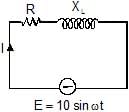
- a)2 volts
- b)10 volts
- c)zero
- d)4.8 volts
Correct answer is option 'D'. Can you explain this answer?
An ac-circuit having supply voltage E consists of a resistor of resistance 3W and an inductor of reactance 4W as shown in the figure. The voltage across the inductor at t = p/w is
a)
2 volts
b)
10 volts
c)
zero
d)
4.8 volts

|
EduRev Support answered |
Here,
XL = 4 Ω
R = 3 Ω
Z = √(XL2 + R2)=√(42 + 32)
= 5 Ω
E0 = 10 V
In the LR circuit current in the ckt is given by
I = (E0/Z)sin(ωt - Φ)
Φ = tan-1(XL/R)
=> Φ = tan-1(4/3)
I = (E0/Z)sin(ωt - Φ)
= (10/5) sin(ωt - Φ)
I at t = T/2
= 2sin(ωT/2 – Φ)
= 2sin(π - Φ)
= 2sin(tan-1(4/3))
= 2×0.8
= 1.6 A
Potential difference across the resistor = 1.6×R
= 1.6×3
= 4.8 V
Potential difference across the inductor = 1.6XL
= 1.6×4 = 6.4 V
XL = 4 Ω
R = 3 Ω
Z = √(XL2 + R2)=√(42 + 32)
= 5 Ω
E0 = 10 V
In the LR circuit current in the ckt is given by
I = (E0/Z)sin(ωt - Φ)
Φ = tan-1(XL/R)
=> Φ = tan-1(4/3)
I = (E0/Z)sin(ωt - Φ)
= (10/5) sin(ωt - Φ)
I at t = T/2
= 2sin(ωT/2 – Φ)
= 2sin(π - Φ)
= 2sin(tan-1(4/3))
= 2×0.8
= 1.6 A
Potential difference across the resistor = 1.6×R
= 1.6×3
= 4.8 V
Potential difference across the inductor = 1.6XL
= 1.6×4 = 6.4 V
Directions : In the following questions, A statement of Assertion (A) is followed by a statement of Reason (R). Mark the correct choice as.Assertion (A): An alternator is a machine which converts mechanical energy into electrical energy.Reason (R): When a coil rotates in a magnetic field an e.m.f. is induced in it.- a)Both A and R are true and R is the correct explanation of A
- b)Both A and R are true but R is NOT the correct explanation of A
- c)A is true but R is false
- d)A is false and R is true
Correct answer is option 'A'. Can you explain this answer?
Directions : In the following questions, A statement of Assertion (A) is followed by a statement of Reason (R). Mark the correct choice as.
Assertion (A): An alternator is a machine which converts mechanical energy into electrical energy.
Reason (R): When a coil rotates in a magnetic field an e.m.f. is induced in it.
a)
Both A and R are true and R is the correct explanation of A
b)
Both A and R are true but R is NOT the correct explanation of A
c)
A is true but R is false
d)
A is false and R is true
|
|
Suresh Iyer answered |
Alternator is basically a generator in which a coil rotates in a strong magnetic field and according to laws of electromagnetic induction e.m.f. is generated. So, assertion and reason both are true and reason explains the assertion.
The average power dissipation in pure inductance is:- a)

- b)2LI2
- c)zero
- d)

Correct answer is option 'C'. Can you explain this answer?
The average power dissipation in pure inductance is:
a)
b)
2LI2
c)
zero
d)

|
Ayush Joshi answered |
Zero .. power = Irms Vrms cosǿ... where ǿ is angle between volatage and current vector... For pure inductance circuit the ǿ=90.. thus power is zero as cos90 is 0
When Ø is the phase difference, what is the power factor?- a)tan Ø
- b)cosh Ø
- c)cos Ø
- d)sin Ø
Correct answer is option 'C'. Can you explain this answer?
When Ø is the phase difference, what is the power factor?
a)
tan Ø
b)
cosh Ø
c)
cos Ø
d)
sin Ø
|
|
T.ttttt answered |
Cos Ø is called a power factor that indicates what fraction of [(Voltage V) x (Current I)] becomes the useful power. Most electric circuits have resistance and inductance. In such electric circuit, the current lags the voltage by the phase difference.
When an emf E = 7cos wt is applied across a circuit, the current is I = 5coswt. What is the power factor for the circuit?- a)infinite
- b)3/4
- c)zero
- d)1
Correct answer is option 'D'. Can you explain this answer?
When an emf E = 7cos wt is applied across a circuit, the current is I = 5coswt. What is the power factor for the circuit?
a)
infinite
b)
3/4
c)
zero
d)
1
|
|
Hansa Sharma answered |
Since E and I are in the same phase.
Therefore, phase difference will be 0 and since power factor= cosx (where x= phase difference) and x =0
therefore, cos x or power factor will be =1
Therefore, phase difference will be 0 and since power factor= cosx (where x= phase difference) and x =0
therefore, cos x or power factor will be =1
If a resistor is connected across the voltage source and the frequency of voltage and current wave form is 50Hz, then what is frequency of instantaneous power- a)0 Hz.
- b)100 Hz.
- c) 50 Hz.
- d)150 Hz.
Correct answer is option 'B'. Can you explain this answer?
If a resistor is connected across the voltage source and the frequency of voltage and current wave form is 50Hz, then what is frequency of instantaneous power
a)
0 Hz.
b)
100 Hz.
c)
50 Hz.
d)
150 Hz.

|
Ayush Joshi answered |
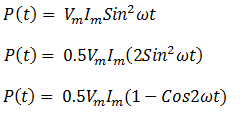 ]
]Therefore, frequency is doubled for the instantaneous power so, frequency of instantaneous power is 100Hz.
In an L-R-C series circuit, the rms voltage across the resistor is 30.0 V, across the capacitor it is 90.0 V, and across the inductor it is 50.0 V. Rms voltage of the source is- a)60.0 V
- b)50.0 V
- c)65.0 V
- d)5.0 V
Correct answer is option 'A'. Can you explain this answer?
In an L-R-C series circuit, the rms voltage across the resistor is 30.0 V, across the capacitor it is 90.0 V, and across the inductor it is 50.0 V. Rms voltage of the source is
a)
60.0 V
b)
50.0 V
c)
65.0 V
d)
5.0 V
|
|
Rajat Kapoor answered |
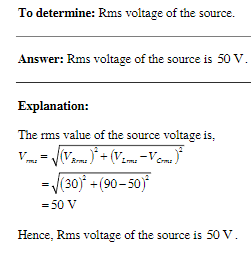
This Question Answer is
A sinusoidal voltage of peak value 283 V and frequency 50 Hz is applied to a series LCR circuit in which R = 3 Ω, L = 25.48 mH, and C = 796 μF. Power dissipated in the circuit; and the power factor are- a)4000 W, 0.4
- b)4800 W, 0.6
- c)4400 W, 0.6
- d)3800 W, 0.6
Correct answer is option 'B'. Can you explain this answer?
A sinusoidal voltage of peak value 283 V and frequency 50 Hz is applied to a series LCR circuit in which R = 3 Ω, L = 25.48 mH, and C = 796 μF. Power dissipated in the circuit; and the power factor are
a)
4000 W, 0.4
b)
4800 W, 0.6
c)
4400 W, 0.6
d)
3800 W, 0.6
|
|
Nandini Iyer answered |
Angular frequency of the ac signal w=2πν
∴ w=2π(50)=100π
Capacitive reactance Xc=1/wC
∴ Xc=1/(100π×786×10−6)=4Ω
Inductive reactance XL=wL
∴ XL=100π×(25.48×10−3)=8Ω
Impedance of the circuit Z=√[R2+(XL−Xc)2]
∴ Z=√[32+(8−4)2]=5Ω
Phase difference ϕ=tan−1[(XL−Xc)R]
Or ϕ=tan−1((8−4)/3)=tan−1(4/3)
⟹ ϕ=53.13o
Power factor cosϕ=cos53.13o=0.6
Power dissipated in the circuit
P=Iv2R
Now, Iv=I0/√2=E0/√2Z=283/(1.414×5)=40A
∴P=Iv2R=(40)2×3=4800 watt
∴ w=2π(50)=100π
Capacitive reactance Xc=1/wC
∴ Xc=1/(100π×786×10−6)=4Ω
Inductive reactance XL=wL
∴ XL=100π×(25.48×10−3)=8Ω
Impedance of the circuit Z=√[R2+(XL−Xc)2]
∴ Z=√[32+(8−4)2]=5Ω
Phase difference ϕ=tan−1[(XL−Xc)R]
Or ϕ=tan−1((8−4)/3)=tan−1(4/3)
⟹ ϕ=53.13o
Power factor cosϕ=cos53.13o=0.6
Power dissipated in the circuit
P=Iv2R
Now, Iv=I0/√2=E0/√2Z=283/(1.414×5)=40A
∴P=Iv2R=(40)2×3=4800 watt
What is the average power consumed/cycle in ideal capacitor.- a)infinite
- b)0
- c)EvIv
- d)cannot calculate it
Correct answer is option 'B'. Can you explain this answer?
What is the average power consumed/cycle in ideal capacitor.
a)
infinite
b)
0
c)
EvIv
d)
cannot calculate it
|
|
Prateek Jain answered |
Explanation:
In an ideal capacitor, there is no power dissipation as there is no resistance in the circuit. Therefore, the average power consumed per cycle is zero. This can be explained by the following points:
- An ideal capacitor is a passive component that stores energy in an electric field between its plates.
- When a capacitor is connected to a voltage source, it charges up to the source voltage and stores energy in the electric field.
- During the charging process, current flows into the capacitor, but there is no power dissipation as there is no resistance in the circuit.
- Once the capacitor is fully charged, there is no current flow and hence no power consumption.
- During discharge, the capacitor releases the stored energy and current flows out of the capacitor, but again there is no power dissipation as there is no resistance in the circuit.
- This charging and discharging process repeats itself in an AC circuit, but the average power consumed per cycle is zero as there is no power dissipation.
Therefore, the correct answer is option 'B' which states that the average power consumed per cycle in an ideal capacitor is zero.
In an ideal capacitor, there is no power dissipation as there is no resistance in the circuit. Therefore, the average power consumed per cycle is zero. This can be explained by the following points:
- An ideal capacitor is a passive component that stores energy in an electric field between its plates.
- When a capacitor is connected to a voltage source, it charges up to the source voltage and stores energy in the electric field.
- During the charging process, current flows into the capacitor, but there is no power dissipation as there is no resistance in the circuit.
- Once the capacitor is fully charged, there is no current flow and hence no power consumption.
- During discharge, the capacitor releases the stored energy and current flows out of the capacitor, but again there is no power dissipation as there is no resistance in the circuit.
- This charging and discharging process repeats itself in an AC circuit, but the average power consumed per cycle is zero as there is no power dissipation.
Therefore, the correct answer is option 'B' which states that the average power consumed per cycle in an ideal capacitor is zero.
A light bulb is rated at 50W for a 220 V supply. The resistance of the bulb, the peak voltage of the source and the rms current through the bulb are- a)768 ΩΩ, 391 V, 0.297A
- b)968 ΩΩ, 311 V, 0.227A
- c)468 ΩΩ, 411 V, 0.267A
- d)968 ΩΩ, 350 V, 0.327A
Correct answer is option 'B'. Can you explain this answer?
A light bulb is rated at 50W for a 220 V supply. The resistance of the bulb, the peak voltage of the source and the rms current through the bulb are
a)
768 ΩΩ, 391 V, 0.297A
b)
968 ΩΩ, 311 V, 0.227A
c)
468 ΩΩ, 411 V, 0.267A
d)
968 ΩΩ, 350 V, 0.327A
|
|
Preeti Iyer answered |
Given P=50W, Vrms=220V,
by P=Vrms2/R
or R=Vrms2/P= 2202/50=968Ω
The peak voltage of the source is,
Erms=E0/√2
=>E0=Erms x √2=220√2=311.13V
Now,
Irms=Vrms/R
=220/968
=0.227A
Hence option B is correct.
by P=Vrms2/R
or R=Vrms2/P= 2202/50=968Ω
The peak voltage of the source is,
Erms=E0/√2
=>E0=Erms x √2=220√2=311.13V
Now,
Irms=Vrms/R
=220/968
=0.227A
Hence option B is correct.
Q factor is- a)

- b)αR
- c)

- d)αR2
Correct answer is option 'A'. Can you explain this answer?
Q factor is
a)
b)
αR
c)
d)
αR2

|
Divey Sethi answered |
Q-factor: In LCR Circuit, the ratio of resonance frequency to the difference of its neighbouring frequencies so that their corresponding current is 1/√2 times of the peak value, is called Q-factor of the circuit.
Formula: Q=(1/R) √(L/C)
So, Q ∝1/R
Conditions for the large value of Q factor:
(i) Value of CL should be large.
(ii) Value of R should be less.
Formula: Q=(1/R) √(L/C)
So, Q ∝1/R
Conditions for the large value of Q factor:
(i) Value of CL should be large.
(ii) Value of R should be less.
At resonance the current in an LCR circuit- a)is maximum
- b)is local minimum
- c)is zero
- d)is minimum
Correct answer is option 'A'. Can you explain this answer?
At resonance the current in an LCR circuit
a)
is maximum
b)
is local minimum
c)
is zero
d)
is minimum
|
|
Harsh Singhal answered |
Current is max.bcz impedance is minimum
If the instantaneous current in a circuit is given by i = 2 cos (ωt + φ) A, the rms value of the current is
- a)√2 A
- b)2√2 A
- c)2 A
- d)0 A
Correct answer is option 'A'. Can you explain this answer?
If the instantaneous current in a circuit is given by i = 2 cos (ωt + φ) A, the rms value of the current is
a)
√2 A
b)
2√2 A
c)
2 A
d)
0 A
|
|
Nikita Singh answered |
i=2cost
=Imcost
So, Im=2amp
IRMS=Im/√2
=2/√2
=√2amp
=Imcost
So, Im=2amp
IRMS=Im/√2
=2/√2
=√2amp
In a series RCL circuit at resonance the applied ac voltage is 220 V. The potential drop across the inductance is 110V, what is the potential drop across the capacitor?- a)220 V
- b)220 √2 V
- c)110 √2 V
- d)110 V
Correct answer is option 'D'. Can you explain this answer?
In a series RCL circuit at resonance the applied ac voltage is 220 V. The potential drop across the inductance is 110V, what is the potential drop across the capacitor?
a)
220 V
b)
220 √2 V
c)
110 √2 V
d)
110 V
|
|
Nandini Iyer answered |
At resonance, the potential drop across the capacitance is equal and opposite to that of inductance i.e. 110V.
You have a special light bulb with a very delicate wire filament. The wire will break if the current in it ever exceeds 1.50 A, even for an instant. What is the largest root-mean-square current you can run through this bulb?- a)1.46 A
- b)1.06 A
- c)1.26 A
- d)1.56 A
Correct answer is option 'B'. Can you explain this answer?
You have a special light bulb with a very delicate wire filament. The wire will break if the current in it ever exceeds 1.50 A, even for an instant. What is the largest root-mean-square current you can run through this bulb?
a)
1.46 A
b)
1.06 A
c)
1.26 A
d)
1.56 A
|
|
Lavanya Menon answered |
Given,
We are given the current I=1.5Am where the wire will break.
We are asked to determine the root mean square of the current Irms. The maximum current here represents the current that just after it the wire will break. The maximum value of the current is the amplitude of the current wave and it should be larger than the root mean square of the current. Using equation, we can get the Irms in the form,
Irms = Imax/√2
The term, 1/√2, times any factor represents the root mean square of this factor, Now, plug the value for Imax into equation 1 and get Irms
Irms=Imax/√2
=1.5A/√2
=1.06A.
We are given the current I=1.5Am where the wire will break.
We are asked to determine the root mean square of the current Irms. The maximum current here represents the current that just after it the wire will break. The maximum value of the current is the amplitude of the current wave and it should be larger than the root mean square of the current. Using equation, we can get the Irms in the form,
Irms = Imax/√2
The term, 1/√2, times any factor represents the root mean square of this factor, Now, plug the value for Imax into equation 1 and get Irms
Irms=Imax/√2
=1.5A/√2
=1.06A.
The impedance of a 10 microfarad capacitor for 50 Hz ac is:
- a)2 ohm
- b)1000 ohm
- c)1000 / π ohm
- d)20 ohm
Correct answer is option 'C'. Can you explain this answer?
The impedance of a 10 microfarad capacitor for 50 Hz ac is:
a)
2 ohm
b)
1000 ohm
c)
1000 / π ohm
d)
20 ohm
|
|
Hansa Sharma answered |
Impedance(XC)=1/ωC
=1/ 2πfC
=1/2πx50x10x10-6
=106/1000π
XC=103/π=(1000/π) Ω
=1/ 2πfC
=1/2πx50x10x10-6
=106/1000π
XC=103/π=(1000/π) Ω
In purely inductive circuits, the current:- a)lags behind voltage by π/2
- b)lead the voltage by π/2
- c)is in phase with the voltage
- d)none of the above
Correct answer is option 'A'. Can you explain this answer?
In purely inductive circuits, the current:
a)
lags behind voltage by π/2
b)
lead the voltage by π/2
c)
is in phase with the voltage
d)
none of the above

|
Bs Academy answered |
Explanation:
- Inductive Circuits:
In purely inductive circuits, the current lags behind the voltage by π/2 (90 degrees). This is because in an inductive circuit, the voltage leads the current due to the phase shift caused by the presence of inductance.
- Phase Relationship:
When an alternating current passes through an inductor, a back EMF is induced in the coil which opposes the flow of current. This causes the current to lag behind the voltage in an inductive circuit.
- Mathematical Representation:
Mathematically, this phase shift can be represented as a phase angle of π/2 (90 degrees) between the current and voltage in a purely inductive circuit.
- Conclusion:
Therefore, in purely inductive circuits, the current lags behind the voltage by π/2 due to the inherent characteristics of inductors to oppose changes in current flow.
- Inductive Circuits:
In purely inductive circuits, the current lags behind the voltage by π/2 (90 degrees). This is because in an inductive circuit, the voltage leads the current due to the phase shift caused by the presence of inductance.
- Phase Relationship:
When an alternating current passes through an inductor, a back EMF is induced in the coil which opposes the flow of current. This causes the current to lag behind the voltage in an inductive circuit.
- Mathematical Representation:
Mathematically, this phase shift can be represented as a phase angle of π/2 (90 degrees) between the current and voltage in a purely inductive circuit.
- Conclusion:
Therefore, in purely inductive circuits, the current lags behind the voltage by π/2 due to the inherent characteristics of inductors to oppose changes in current flow.
What is phase angle given R = 10, Z = 20- a)30°
- b)45°
- c)60°
- d)90°
Correct answer is option 'C'. Can you explain this answer?
What is phase angle given R = 10, Z = 20
a)
30°
b)
45°
c)
60°
d)
90°

|
Manvi Goyal answered |
Cos x (power factor) = R/Z
= 10/20
=1/2
x= 60
= 10/20
=1/2
x= 60
Chapter doubts & questions for Alternating Current - NCERT Based Tests for NEET 2025 is part of NEET exam preparation. The chapters have been prepared according to the NEET exam syllabus. The Chapter doubts & questions, notes, tests & MCQs are made for NEET 2025 Exam. Find important definitions, questions, notes, meanings, examples, exercises, MCQs and online tests here.
Chapter doubts & questions of Alternating Current - NCERT Based Tests for NEET in English & Hindi are available as part of NEET exam.
Download more important topics, notes, lectures and mock test series for NEET Exam by signing up for free.

Contact Support
Our team is online on weekdays between 10 AM - 7 PM
Typical reply within 3 hours
|
Free Exam Preparation
at your Fingertips!
Access Free Study Material - Test Series, Structured Courses, Free Videos & Study Notes and Prepare for Your Exam With Ease

 Join the 10M+ students on EduRev
Join the 10M+ students on EduRev
|

|
Create your account for free
OR
Forgot Password
OR
Signup on EduRev and stay on top of your study goals
10M+ students crushing their study goals daily

